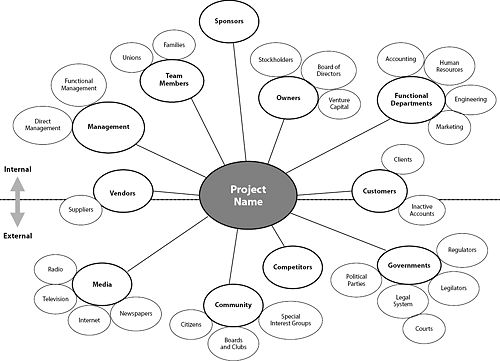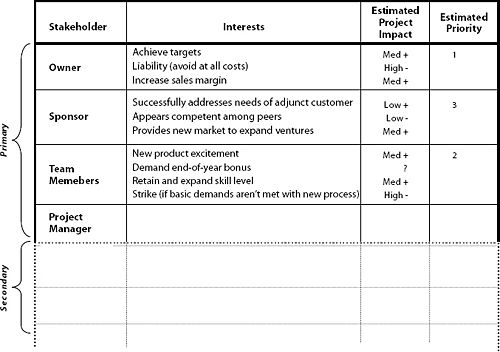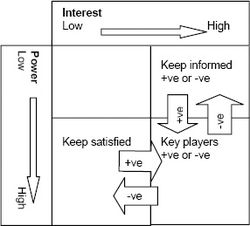Project Stakeholder Management
Sasha Mantel
Contents |
Abstract
According to the Project Management Institute (PMI), project stakeholder management is defined as "the processes required to identify the people, groups or organizations that could impact or be impacted by a decision, action or outcome of the project, and to analyze stakeholder interests, relationships and potential impact on project success." This article goes through the different aspects of this definition and then identifies why effective project stakeholder management is critical to the success of a project as it helps to build support, ensure alignment with stakeholders, and manage potential risks and challenges.
Moreover, project stakeholder management can be more challenging in the context of a public project, such as public procurements. They often involve a wider range of stakeholders with diverse and conflicting interests. These stakeholders may include government agencies, residents, businesses, environmental organizations, and community groups, among others. Stakeholders may have different opinions about the project goals and outcomes and also concerns about the impact of the project on their community or environment. Additionally, the public nature of the project may attract greater scrutiny and media attention, increasing the pressure on the project team to manage stakeholder expectations and mitigate any negative impacts. It is given here proposals of lines of conduct in the management of actors on a public project.
Definition
History of stakeholder management theory [1]
The fatherhood of stakeholder management theory has largely been attributed to R. Edward Freeman with his book Strategic Management: A Stakeholder Point of View published in 1984. This new theory is born as an opposition to The Managerial View of the Firm or a The Production View of the Firm. But even according to Freeman, we owe the stakeholder theory to different movements and thinkers who inspired it. On one hand, the early advocates of a Stakeholder theory underlined the importance of the different people or groups of people that affect or are affected by a company, after an industrial revolution that led to bigger and more complex companies than the usual family business. Also, publications like King and Cleland in 1978 emphasized the responsibilities and moral obligations of a company towards their stockholders, managers, and employees, but also suppliers, distributors, supporting service organizations, and finally the public and their clients. Later on, the word stakeholder was applied to several less traditional groups ("the community", "the public"). A stakeholder point of view appeared in strategic management literature:
For a long time, we have assumed that the views and initiative of stakeholders could be dealt with as externalities to the strategic planning and management process; as data to help management shape decisions, or as legal and social constraints to limit them. We have been reluctant, though, to admit the idea that some of these out-side stakeholders might seek and earn active participation with management to make decisions. The move today is from stakeholder influence towards stakeholder participation
Dill, 1975, cited in Freeman's book (1984)
The first research papers on Project Stakeholder Management came in the late 2000s. At first, they mainly looked for principles in Stakeholder management theory that are relevant to project management (Drouin and Jugdev, 2013).
Definition and main principles
Project stakeholder management corresponds to the process of analyzing stakeholders, organizing communication, and understanding their expectations, interests, and influence on a project. A formal definition of a stakeholder according to the Project Management Institute (1996) is: “individuals and organizations who are actively involved in the project, or whose interests may be positively or negatively affected as a result of project execution or successful project completion”. Project Stakeholder Management ensures that a project meets stakeholders' expectations, taking into account that different stakeholders may have different expectations and definitions of project success.
Importance of stakeholder management
Implication and monitoring of stakeholders in the process of the project are essential for several reasons :
- A project needs resources, financial and non-financial, provided by stakeholders
- The stakeholders will establish the criteria to assess the success of the project
- They will be the ones directly or indirectly impacted (positively or negatively) by the project and its potential success
- A form of resistance from them can harm the project's success likelihood
Good management of the stakeholders allows for smooth communication, stakeholder engagement, and goal alignment and therefore reduces project risks. Also, poor stakeholder management can increase the complexity of a project. The close monitoring of their expectations, their influence on the project, and their resources allow the project manager to be proactive on a broad variety of potential conflicts and issues that could arise. In the context of a significant project investor, effective management of their objectives and expectations will be essential to reduce the risk of their dissatisfaction with the project and the potential withdrawal of their resources. If there are irreconcilable conflicts between the investor's interests and the project's goals, effective project management can hopefully detect them earlier, providing valuable time to explore and implement solutions if the investor withdraws from the project.
Examples of classic stakeholders included in a project are the project manager, the customer, team members within the performing organization, and the project sponsor. But further analysis is necessary to define all the stakeholders and to understand their importance, expectations, possible resources, ... This is the stakeholder analysis, the first tool for a project stakeholder management process. It involves using various methods to identify and understand the needs and expectations of internal and external stakeholders both within and outside of the project environment.
Understanding Stakeholders through analysis
The different types of stakeholders
The first step of a stakeholder analysis is to identify and categorize the project's different stakeholders. The step is crucial as it will later allow us to know quickly and clearly how to communicate and handle different stakeholders, or which group of stakeholders to address for specific issues. Some differentiation has to be taken into account when a stakeholder analysis is performed :
- The stakeholders can be individuals or groups,
- they can be impacted by the outcome of the project directly or indirectly,
- they can be implicated in the daily activities of a project or only contribute punctually or on a more general level
Some vocabulary is generally used to describe a stakeholder status within a project :
- Internal/External: Different definitions can be found, but on a general level the internal stakeholder participates actively in the project execution whereas an external one is mainly affected by the outcome of the project. Other definitions will emphasize that internal stakeholders are part of the organization that is responsible for the project. Examples of external stakeholders in a public sector project are national and local authorities, public goods, licensing and surveying organizations, research institutes, consulting firms, and private interest groups such as stockholders, union workers, and pressure groups. [2]
- A construction stakeholder is an individual (or group of individuals) who has a significant impact on the success of a project
- Primary/Secondary[3]: Primary stakeholders are those with official (financial or non-financial) relationships with the organization (through a contract, a partnership for instance) whereas secondary stakeholders are not directly related to the organization even though the outcome of the project can have a direct positive or negative effect on them.
- Environmental/Process Related [4]
- Other: Claimants, influencers, …
Setting the importance and the influence
The most important when assessing the stakeholder landscape is to determine for each of them their interests, and the impact there might be if their interests were not met. After the different stakeholders have been identified and characterized, different tools and templates are available to assess their needs and power.
Interest and Impact Table
The idea behind an Interest and Impact table is to create a table with all identified stakeholders and then to identify each of their interests. It's important to identify both stated and hidden interests. The last ones can be found by considering the characteristics listed above, their needs, and concerns. Then for each of those interests, the level of the potential impact on the project, if the interest is not met, has to be determined. influence, authority, expertise, and resources can be considered. Finally, their relative priority compared to other stakeholders. In the example the following annotations are used : (+) for positive, (-) for negative, or (?) for unknown, as well as (H) for high, (M) for medium, (L) for low, or (?) for uncertain impact levels. Finally prioritizing stakeholders' interests can subsequently help in decision-making when not all objectives can be met, or at least not at the same time.
Interest and Power Matrix
This diagram allows the project stakeholder manager to have an overview of the influence and the importance of every stakeholder. For instance, stakeholders in the high influence—high importance quadrant will be considered key stakeholders. It is important to consider the stakeholder point of view when building this matrix. Significant financial support coming from an organization does not necessarily imply that the organization is gonna have a strong interest in the progress of the project. On another hand, it can also help the manager to prioritize the time and resources he will put into communication and problem-solving with each of the stakeholders.
For every corner of the matrix, different behaviors and good communication practices can be implemented. Key stakeholders (bottom right corner) is the group where the time resources need to be spent. They are the first that should be involved in decision processes and first-priority communication channels. They can be good advocates of the project if people need to be convinced. It is important to regularly keep in contact with them even though they are not part of an issue at some point. For High Power, Low Interest stakeholders: Even though they are not taking an active role in the project, it is truly important to know what is important to them and how the project could start to harm them, to avoid it.[5]
Project Stakeholder management in the context of a public project
In this article, we will focus on the project stakeholder management challenges that occur particularly in the public sector. Those projects almost all the time involve a wide range of stakeholders, with very different types of resources and influence, and also sometimes conflictual interests. Moreover, public sector projects have long-term socioeconomic effects on the country, and inefficient management of the stakeholder can have a profound negative impact, economic as well as political and social. In their paper Stakeholder Management in Public Sector Infrastructure Projects, Waris and al. emphasize the need for the public sector to research and implement better and more efficient stakeholder management in these projects considering the growing demand, mostly in developing countries[6]. Stakeholder management can face a wide range of challenges in public sector projects.
Complex stakeholder landscape
Public sector projects imply a wide range of stakeholders, each with their interests, needs, and concerns. They are often from different professional and technical backgrounds, varying degrees, and types of project objectives. Being able to understand and define individual interests is key to conflicts linked to miscommunication, or a feeling of incomprehension. Also, an idea could be to perform several stakeholder analysis through the different phases of the project, as the interests and expectations of the different stakeholders evolve. This diversity must be seen as a strength; having different expertise, gathered and invested permits to prevent project failures. Therefore, understanding stakeholders’ perceptions of development projects is an important factor when considering the success or failure of public projects.[7]
An easy way to cope with a complex stakeholder landscape is to use stakeholder management software, to ease the tracking and management of stakeholder needs and expectations.
Political sensitivity
Political influence has an impact on project goals, budgeting, and stakeholders. Large sums of public money are involved, impact on local communities can negatively trigger stakeholders that have not even been considered at the beginning. The best way to manage stakeholders in a politically sensitive environment is to build transparent and trustful relationships with the key stakeholders. Anticipating political divergences between the different stakeholders can help to get ahead of difficult situations. The involvement of politically sensitive stakeholders in the decision-making process can help reduce political tension through active communication, or on the contrary increase the political debate.
Public scrutiny
Public sector projects generate intense public scrutiny that can lead to increased stakeholder expectations and heightened concerns. Stakeholder relationships become public ones and can add tensions to conflictual situations. The public, as a group, has to be considered as an external stakeholder with its interest and influence. Making it involved in the project - through public consultations, and citizen assemblies. It can help build support for the project.
Time and resources constraints
Public procurement projects often operate under tight time constraints, which can make it difficult to allocate sufficient time and resources to stakeholder management. It can impact the ability of the project team to effectively manage stakeholders. Several recent researches and studies have shown that the implementation of Stakeholder management in public projects is a real need that is too often neglected. Allocating enough time to analyze stakeholders' expectations and influence allows for more confident relationship management, and saves time when it comes to prioritizing actions and result targets.
Regulation and bureaucratic processes
Complex bureaucratic procedures increase the difficulty to respond to stakeholder concerns and feedback on time. Decision processes can be long and implicate a large range of stakeholders. Manage stakeholders' expectations with clear communication about the delays regarding authorization and validation processes.
References
- ↑ Eskerod, P., Huemann, M., & Savage, G. (2015). Project Stakeholder Management—Past and Present. Project Management Journal, 46(6), 6–14. https://doi.org/10.1002/pmj.21555
- ↑ Parnell, Driscoll and Henderson, 2011
- ↑ Savage et al. (1991)
- ↑ Atkinson et al. (1997)
- ↑ Vogwell, D. (2003). Stakeholder management. Paper presented at PMI® Global Congress 2003—EMEA, The Hague, South Holland, The Netherlands. Newtown Square, PA: Project Management Institute.
- ↑ Waris, et al. Stakeholder Management in Public Sector Infrastructure Projects. Journal of Engineering, Project, and Production Management 2022, 12(3), 188-201
- ↑ Dick-Sagoe, C., Lee, K.Y., Odoom, D. et al. Stakeholder perceptions on causes and effects of public project failures in Ghana. Humanit Soc Sci Commun 10, 14 (2023). https://doi.org/10.1057/s41599-022-01497-7


